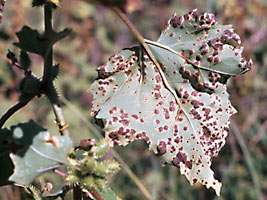Noogoora burr throws researchers a curve ball

(PhysOrg.com) -- What do you do when a weed fights back? Noogoora burr in Australia’s tropical north has done just that but CSIRO scientists aren’t letting it get away with it.
Noogoora burr (Xanthium occidentale) is one of our nastiest invasive plants. Its burrs contaminate wool and injure people and stock and its seedlings poison stock. The weed forms monocultures across Australia’s north and could spread much further, curtailing costly containment efforts.
CSIRO Entomology and the CRC for Australian Weed Management’s Dr Louise Morin has been investigating the exotic rust fungus, Puccinia xanthii, which was illegally or accidentally introduced to Australia in the mid-1970s, and has been highly effective in controlling Noogoora burr in south-eastern Queensland.
“Unfortunately the rust has been ineffective in the tropical north so we started investigating the possible introduction of additional strains better adapted to the tropics that would enhance biocontrol in those areas,” Dr Morin said.
After finding the rust at various locations in tropical America, the team obtained permission to bring several strains back to the CSIRO Black Mountain Containment Facility for further testing.
“That’s when the weed threw the team a curve ball,” Dr Morin said. “None of the extra strains would infect Australian Noogoora burr. Australian rust strains, on the other hand, produced severe symptoms. So we couldn’t establish cultures of these exotic strains and perform the host-specificity tests necessary before approval for release could be given. Plants developed typical resistance reactions when inoculated with the imported strains. That’s when the detective work began back where the rust strains came from – the Dominican Republic and Mexico.”
Dr Morin found that the burr plants from which the strains had been collected were genetically different to their Australian counterparts. And these differences could explain why the tropical American rust strains couldn’t infect Australian Noogoora burr.
“It’s more complicated than we first thought but we now know the system better and have laid the groundwork for future success,” she said.
“In future, we hope to find out where Australian Noogoora burr originally came from and look there for pathogenic rust strains. If this can’t be achieved, we will consider establishing an outdoor garden of Australian Noogoora burr in tropical America to attract suitable rust strains.”
Dr Morin said the team developed a molecular method to distinguish between exotic and Australian strains and collaborators from the Northern Territory Department of Natural Resources, Environment and the Arts and the Western Australia Department of Agriculture and Food have monitored Noogoora burr along three rivers in the Northern Territory and northern Western Australia. This will help assess the efficacy of any additional strains of P. xanthii that might be released in Australia.
Provided by CSIRO
















